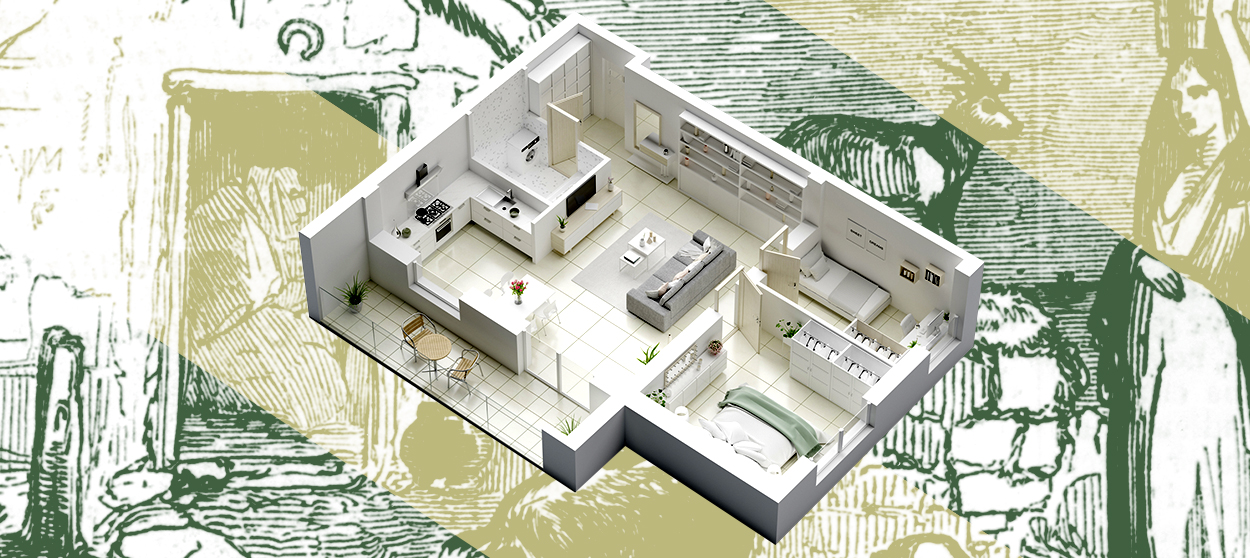Open concept homes are for peasants
The poor throughout most of human history would have suffered in what we now call an "open floor plan"


Jesus was not born in a stable. That's not to say the birth wasn't attended by farm animals — the Gospel of Luke tells us twice the baby's first bed was a feeding trough — but rather that the animals lived in the house.
Peasant homes in first century Bethlehem were designed with what we would today call an "open concept." They typically had one large room with the nicer living space in an open loft or on the roof, while the main floor area was where the family's animals would be brought for safekeeping at night. The guestroom that was unavailable to Jesus, Mary, and Joseph was that loft or roof space, and the big room where they stayed instead served as the kitchen, living room, dining room, and farmyard all at once. The defining feature of Jesus' birthplace was not isolation, as we often tend to think, but an utter lack of privacy: Mary delivered in a crowded farmhouse with few, if any, interior walls.
And that was perfectly normal, if not exactly desirable, for our modern fixation on the open floor plan is a historical anomaly. It flies in the face of literally millennia of consensus that more rooms is better, and it is a dreadful mistake. The last 70 years of open concept construction and remodeling has left us with dysfunctional houses, homes that are less conducive to hospitality, less energy efficient, and more given to mess.
The Week
Escape your echo chamber. Get the facts behind the news, plus analysis from multiple perspectives.

Sign up for The Week's Free Newsletters
From our morning news briefing to a weekly Good News Newsletter, get the best of The Week delivered directly to your inbox.
From our morning news briefing to a weekly Good News Newsletter, get the best of The Week delivered directly to your inbox.
The shift from open concepts demanded by necessity to widespread construction of separate rooms to open concepts demanded by style is relatively recent. Before the 17th century, especially for the poor, "rooms did not have specialized functions," explains architect Witold Rybczynski in Home: A Short History of an Idea. "Houses were full of people, much more so than today, and privacy was unknown."
A single room could serve as a study in the morning, a dining room at noon, a living room in the evening, and a bedroom at night. Beds were couches, and couches were beds. Your house was your workspace, and your minimal furniture typically had no fixed arrangement, as it was constantly moved about to accommodate different uses of the only room available. (The French and Italian words for "furniture" still hint at this history: You can see the similarity to "mobile" in meubles and mobilia.)
These open concepts of old were not only motivated by different conceptions of privacy and the expense of building additional walls. They were also required for the lower classes by premodern heating technologies. A single open hearth, or, later, fireplace or stove, could warm one large room but could not do much for other, closed-off spaces. A lord or king could build a heating element into every room, but for the average family, winter warmth required most of life to happen in a single space.
As technology advanced, ideas about privacy changed, and standards of living improved over the last 500 years, ordinary people were increasingly able to move away from an open concept home, and they eagerly did so. "Rooms began to proliferate as wealthy householders discovered the satisfactions of having space to themselves," notes Bill Bryson in At Home: A Short History of Private Life. Though the transition was slow — toilets long had "multiple seats, for ease of conversation" — rooms were increasingly devoted to particular uses, and those uses were separated from one another as much as resources permitted.
A free daily email with the biggest news stories of the day – and the best features from TheWeek.com
Vernacular homes dating to the 19th and early 20th centuries, of which the United States has many, were built with this background in mind. My own home, constructed in 1915, is fairly typical in this regard. The dining room joins to the living room with a wide archway, but the two spaces are clearly delineated. The kitchen was originally separated from the dining room by a solid door, and though some previous resident in the past century removed it, the rest of the wall dividing the two rooms is left intact.
Too many other historic houses have not fared so well, as taking down a kitchen wall seems to have become many remodelers' first and strongest impulse. New construction has favored wall-less layouts in the main living area for about 50 years, too. While the aesthetic effect is worse in older homes, old and new alike suffer from the many downsides of an open layout which prior generations jettisoned as soon as they could.
Though sold on HGTV as a boon to the entertaining lifestyle, the modern open concept in practice makes hospitality more difficult. A single cooking-dining-living space is difficult to keep clean to the standard many prefer when hosting guests, making impromptu invites tricky. "Messes and smells are no longer isolated, but can be easily tracked throughout the entire first floor of a large home," says architecture critic Kate Wagner at City Lab. Beyond the unpleasantness of having dirty dishes in sight during a dinner party, an open floor plan can make smaller gatherings awkward, failing to provide the sense of intimacy that fosters good conversation. Parties need walls to literally force people together.
And because we no longer heat our homes with a single hearth, wall-less layouts mean energy waste. Heat from the kitchen can't be easily confined in summer months, and climate control can't be isolated to the room you're actually using. The high ceilings and loft spaces popular in newer open concept houses are particularly bad in this regard. They also make DIY home maintenance, like painting and cleaning windows, substantially more difficult.
But perhaps the greatest problem with the modern open concept is that it simply doesn't work well for real life. Open concepts are loud and busy, requiring everyone in shared living spaces to accommodate each other's activities or vacate the area to get a little peace. In the name of togetherness and ease, they make for more annoyance, work, and expense.
Our ancestors had this one right: If you can have separate rooms, do it. And if your historic home still has an enclosed kitchen, for goodness' sake, keep it that way.
Bonnie Kristian was a deputy editor and acting editor-in-chief of TheWeek.com. She is a columnist at Christianity Today and author of Untrustworthy: The Knowledge Crisis Breaking Our Brains, Polluting Our Politics, and Corrupting Christian Community (forthcoming 2022) and A Flexible Faith: Rethinking What It Means to Follow Jesus Today (2018). Her writing has also appeared at Time Magazine, CNN, USA Today, Newsweek, the Los Angeles Times, and The American Conservative, among other outlets.
-
 A luxury walking tour in Western Australia
A luxury walking tour in Western AustraliaThe Week Recommends Walk through an ‘ancient forest’ and listen to the ‘gentle hushing’ of the upper canopy
-
 What Nick Fuentes and the Groypers want
What Nick Fuentes and the Groypers wantThe Explainer White supremacism has a new face in the US: a clean-cut 27-year-old with a vast social media following
-
 5 highly amusing cartoons about rising health insurance premiums
5 highly amusing cartoons about rising health insurance premiumsCartoon Artists take on the ACA, Christmas road hazards, and more
